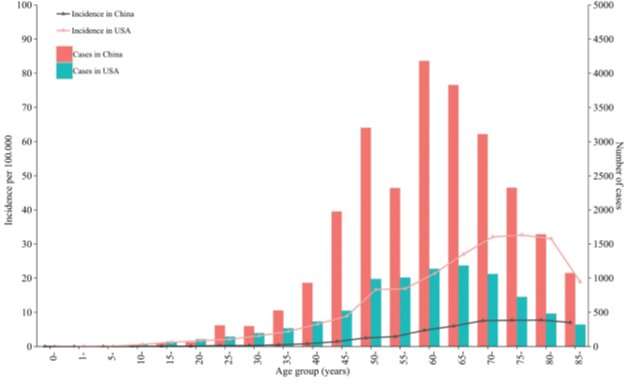This article has been reviewed according to Science X's editorial process and policies. Editors have highlighted the following attributes while ensuring the content's credibility:
fact-checked
proofread
Study compares the incidence of neuroendocrine neoplasms in China and the US

Neuroendocrine neoplasms (NENs) are rare cancers that develop from specialized secretory cells of the neuroendocrine system. These cells are found throughout the body and exhibit features of the nervous and endocrine/hormonal systems. NENs are largely associated with neoplasia of the bronchopulmonary system and the gastrointestinal tract.
They are known for their slow-growing nature and are heterogenous in terms of their clinical behavior. Furthermore, these tumors secrete a variety of peptides and hormones associated with various symptoms. The heterogeneity and non-specific symptoms of NENs may result in misdiagnosis and delayed treatment.
Over the past few decades, the incidence of NENs in several countries has shown an upward trend. A significant increase in the incidence of NENs has been observed in countries such as the United States of America (U.S.), Canada, and Norway. Despite the recognition of NENs as an emerging public health issue, little is known about the epidemiology of NENs in China.
To this end, a team of researchers from China launched a study to comprehensively assess the national incidence and survival of NENs across China. To observe these patterns in a geographically distinct country, they compared these statistics with data from the U.S. for the same period. This study, led by Professor Jie He from the National Cancer Centre of China/ Chinese Academy of Medical Sciences and Peking Union Medical College, was published in the Chinese Medical Journal.
Explaining the rationale behind this work, the researchers believe that, "The nationwide epidemiology profile for NENs has never been studied in large, population-based registries with extensive long-term follow-up in China. Previous studies on epidemiology of NENs in China were limited by samples from individual or a small number of institutions or focusing on some primary sites."
First, the team extracted data on NENs from the National Central Cancer Registry database of China. Next, 246 cancer registries were selected in this study after quality control, covering about 272.5 million people, used to calculate the age-specific incidence of NENs. Then, combined with the national population to estimate the incidence of NENs in China, and the temporal trends of NENs were analyzed.
The team also estimated the survival rate of NENs using data from 176 local cancer registries and analyzed trends with respect to sex, age group, and urban-rural area. Lastly, they obtained the incidence and survival data for NENs in the U.S. from 18 registries using the Surveillance, Epidemiology, and End Results database, which covers approximately 28% of the U.S. population.
The study revealed a lower age-standardized rate (ASR) of NENs incidence in China (1.14 per 100,000) as compared to that in the U.S. (6.26 per 100,000). The most common sites where primary NENs tumors progressed in the Chinese population were found to be the pancreas, stomach, lungs, and the rectum. Notably, the ASR in the incidence of NENs increased annually by 9.8% in China compared with an annual increase of 3.6% in the U.S..
The overall 5-year survival rate was considerably lower in China (36.2%) as compared to that in the U.S. (63.9%). Additionally, the study revealed disparities in the incidence and survival of NENs in China and U.S. across variables including tumor site, sex, age, and urban-rural areas of residence. Female patients and those living in urban areas had a higher 5-year relative survival in China.
Importantly, while these findings suggest a lower incidence of NENs in China than that in the U.S., they also reveal a poorer prognosis and higher rate at which this incidence is increasing in China.
Going ahead, these comprehensive findings can provide a scientific basis for effective NEN management. "A better understanding of patterns and trends of the epidemiology of NENs may not only be poised to inform national policy-making, but also provide a scientific basis on the prevention and control of NENs in these two countries," conclude the researchers, while highlighting the future implications of this study.
More information: Rongshou Zheng et al, Incidence and survival of neuroendocrine neoplasms in China with comparison to the United States, Chinese Medical Journal (2023). DOI: 10.1097/CM9.0000000000002643




















